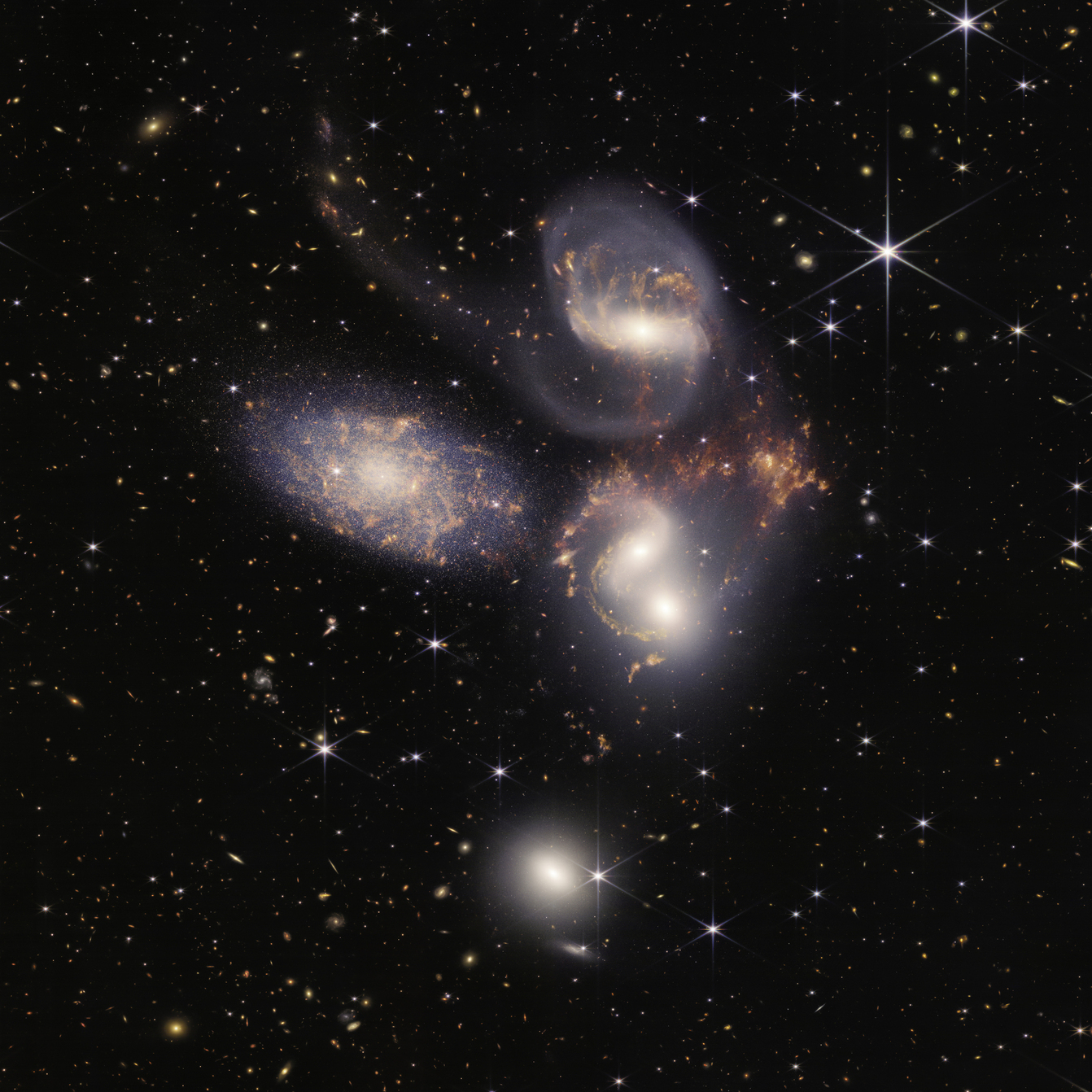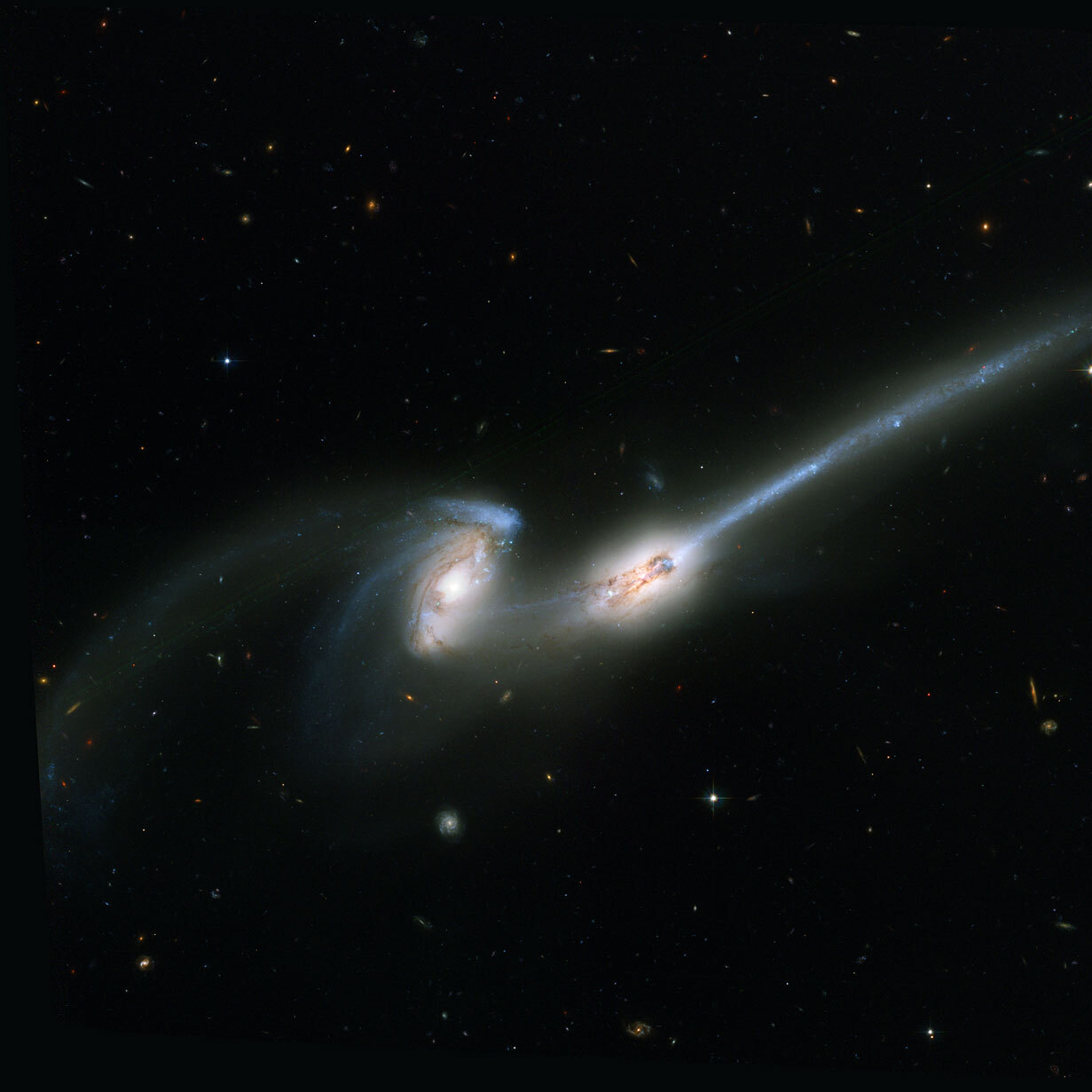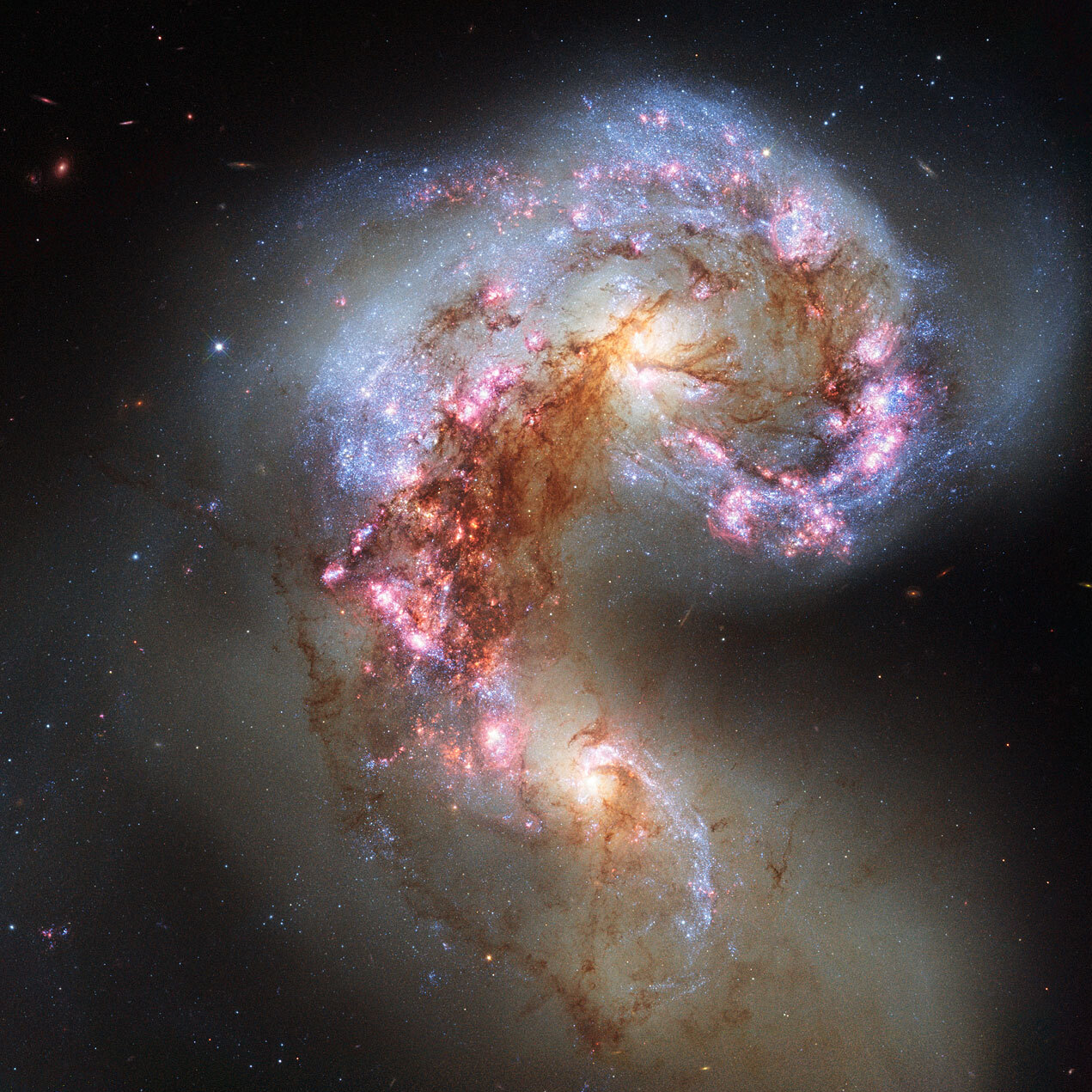19. Hierarchical galaxy formation¶
Ask any astrophysicist what the defining process of galaxy formation in the accepted \(\Lambda\)CDM cosmological framework is and they will say merging. Because of the abundant small-scale power in the primordial density fluctuations, structure formation in \(\Lambda\)CDM is hierarchical with gravitationally-bound dark-matter halos forming from the bottom up (see Chapter 17.4). Thus, small, low-mass dark-matter halos form first at high redshift, larger halos form later, and a large number of small dark-matter halos accrete onto or merge with the larger halos. Because galaxies form within dark-matter halos, this implies that galaxy formation itself is hierarchical, with small galaxies forming at high redshift and many of these accreting onto larger galaxies as satellite galaxies or merging with them and contributing their stars and gas to the larger galaxy.
That galaxy interactions are common is clear from even a superficial examination of the brightest galaxies on the sky. The NGC catalog contains about 4,000 galaxies, a fair number of which are in pairs or larger multiples close together on the sky. Most of these are true physical associations rather than being chance superpositions (one of the galaxies in Stephan’s Quintet shown in Figure 19.1 is a notable exception to this!). And about a dozen of the NGC galaxies show clear signs of interactions in the form of bridges between galaxies or tails extending far from the main body of the galaxies. Some famous examples of interacting galaxies are shown in Figure 19.1.
Figure 19.1: Stephan’s Quintet (NASA, ESA, CSA, STScI; top left); NGC 4676 (NASA, H. Ford, G. Illingworth, M.Clampin, G. Hartig, the ACS Science Team, and ESA; top right); Antennae galaxies (ESA/Hubble & NASA; bottom left); Arp 271, composed of NGC 5426 and NGC 5427 (ESO; bottom right).
Clockwise from the top left, we see Stephan’s Quintet, NGC 4676 (known as the Mice galaxies), NGC 5426 and NGC 5427 (known as Arp 271), and the Antennae galaxies NGC 4038 and NGC 4039. Stephan’s Quintet is a compact grouping of five galaxies, all but the leftmost one of which are physically associated and engaged in an ongoing interaction. The image shown is one of the first images ever taken by JWST and it shows Stephan’s Quintet in a composite of near-infrared and mid-infrared observations. The mid-infrared traces emission by dust associated with the star formation induced as the merger compresses gas. We also see that the main body of the triplet of closely interacting galaxies is significantly distorted from a symmetrical shape and that a long tail emerges from the galaxy at the top. Tails are the most obvious sign of interaction in many galaxy pairs, including in the Mice, and they are caused by the large tidal forces that galaxies exert on another: the image of the Mice illustrates how narrow tails often are. Arp 271 demonstrates another common feature of galaxy interactions: a bridge connecting the two large spiral galaxies. Finally, the Antennae are a prime example of a pair of merging galaxies, with the merger distorting the structure of the galaxies far away from that of the usual spiral-galaxy shape and with a strong burst of star formation where gas is compressed between the merging galaxies (traced by the dark-red dust lanes).
While a dozen interactions among \(\approx 4,000\) galaxies might not seem like much, simple dynamical considerations as well as \(N\)-body simulations demonstrate that obvious signs of interactions persist only for one or a few dynamical times, \(\mathcal{O}(500\,\mathrm{Myr})\), and the true interaction rate is therefore larger by an order of magnitude: assuming a constant interaction rate over the age of the Universe, \(\approx 10\,\mathrm{Gyr} / [500\,\mathrm{Myr}]\times 10 = 200\) galaxies in the NGC catalog have experienced significant interactions with a companion, a rate of about 5%. In fact, the true interaction rate is likely larger, because the Universe was denser in the past, making interactions more likely.
Accretion of dark matter, gas, and stars from smaller systems and interactions and mergers between galaxies are therefore important processes in galaxy formation and evolution. We discuss these in detail in this chapter, starting from a largely observational perspective in Section 19.1. In Section 19.2, we detail the expected growth of dark-matter halos in \(\Lambda\)CDM and in Section 19.3 we discuss how gas included in the initial collapse of a dark-matter halo, and the gas that is accreted later from the cosmic web, is able to cool to form stars and we discuss the important role of feedback in regulating star formation. Finally, in Section 19.4, we cover some of the most important dynamical processes involved in galaxy interactions and mergers: dynamical friction and tides.
One important take-away from this chapter is that, while galaxy interactions and mergers are obvious and fascinating signatures of galaxy evolution, their importance for galaxy evolution as a whole is often overstated. As important, and perhaps even more important, are processes internal to galaxies that occur over a wide range of time scales. These include large-scale and small-scale disk instabilities giving rise to the formation of bars and spiral structure and that are important for star formation in disks, as well as internal kinematic heating mechanisms and the feedback processes associated with massive stars, supernova explosions, and active galactic nuclei. We discuss some of these in the next chapter. In the end, there is no clear delineation between internal and external processes, because, for example, galaxy interactions can seed disk instabilities that grow into large-scale spiral patterns, or gas expelled by supernova explosions joins and interacts with gas accreted from the cosmic web. Thus, we will not focus on distinguishing between internal and external mechanisms, but rather present the physical processes at work during galaxy evolution in as logical a manner as possible.





